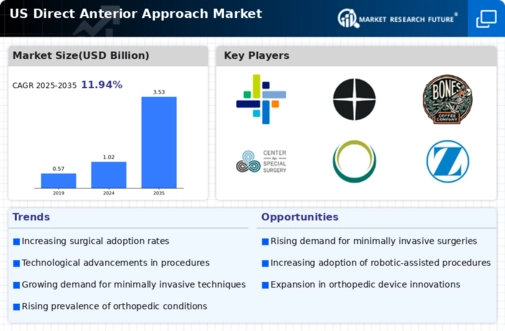Market Analysis
In-depth Analysis of U.S. Direct Anterior Approach Market Industry Landscape
The US Direct Anterior Approach (DAA) market for hip replacement surgery is undergoing significant trends that are reshaping the landscape of orthopedic interventions. A noteworthy trend driving the market is the increasing adoption of the Direct Anterior Approach for hip replacement surgeries. This surgical technique involves accessing the hip joint from the front, minimizing muscle and tissue disruption compared to traditional approaches. As patients and surgeons alike seek less invasive procedures with faster recovery times and reduced postoperative pain, the Direct Anterior Approach has gained popularity as a viable alternative.
Technological advancements are playing a pivotal role in shaping the market trends of the US Direct Anterior Approach. Surgical innovations, including specialized instruments and navigation systems, contribute to the precision and efficiency of DAA procedures. The incorporation of robotics and advanced imaging technologies enhances the surgeon's ability to perform hip replacements with greater accuracy, further fueling the adoption of the Direct Anterior Approach.
Another significant trend is the emphasis on outpatient or same-day hip replacement surgeries facilitated by the Direct Anterior Approach. As advancements in surgical techniques and anesthesia protocols enable quicker recovery, outpatient hip replacements are becoming a viable option for select patients. This trend aligns with the broader healthcare movement towards ambulatory care and patient-centric models, offering increased convenience and reduced healthcare costs for suitable candidates.
Furthermore, the market is witnessing increased collaboration between orthopedic surgeons, medical device manufacturers, and healthcare institutions to refine and optimize the Direct Anterior Approach. Surgeons and industry experts collaborate to share best practices, develop innovative instruments, and streamline the learning curve associated with adopting this technique. This collaborative trend aims to enhance the overall efficiency and effectiveness of DAA procedures, making them more accessible to a broader range of patients.
The rise of value-based care and bundled payment models is influencing the market dynamics of the US Direct Anterior Approach. Healthcare providers and payers are increasingly focused on delivering high-quality care with improved patient outcomes while controlling costs. The potential for reduced hospital stays, quicker recovery, and lower complication rates associated with DAA align with the objectives of value-based care models, making this approach an attractive option for healthcare systems aiming to provide efficient and cost-effective orthopedic services.
Moreover, there is a growing demand for patient education and awareness regarding the benefits and risks of the Direct Anterior Approach. As more patients seek information about available surgical options, orthopedic surgeons and healthcare organizations are actively engaging in educational initiatives to empower individuals in making informed decisions about their hip replacement surgeries. This trend reflects a shift towards shared decision-making and patient-centered care in orthopedics.
Despite these positive trends, challenges such as the learning curve associated with adopting the Direct Anterior Approach and variability in patient outcomes persist. Surgeons transitioning to this technique may face challenges in mastering the specific skills required for DAA procedures. Ongoing education, training programs, and mentorship opportunities are crucial for overcoming these challenges and ensuring the successful integration of the Direct Anterior Approach into mainstream orthopedic practices.










Leave a Comment